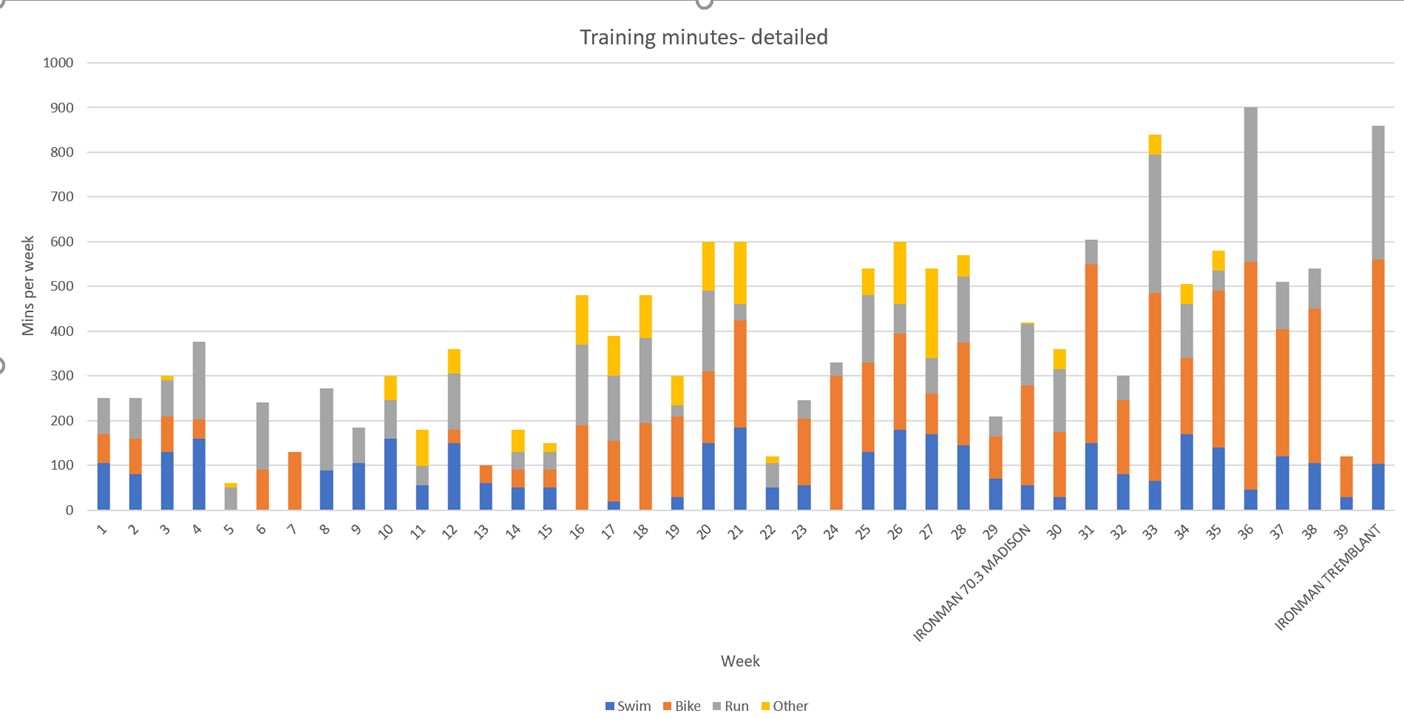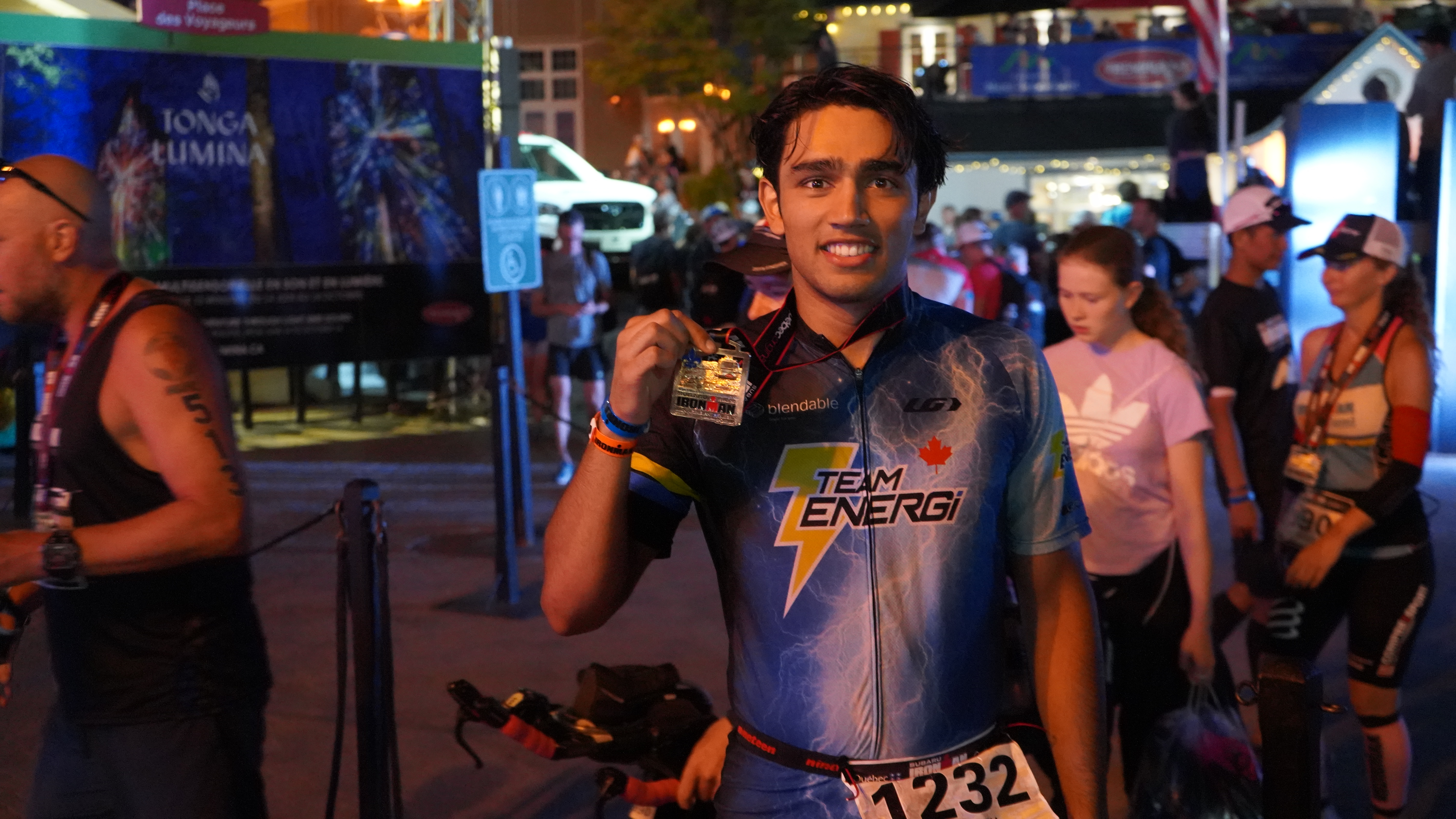My first Ironman
- Published on
- Shreshth Mehra--10 min read
Contents
- Overview
- What training for an Ironman looks like?
- What Training for an Ironman feels like?
- One at a time
- Enjoying the process
- Importance of Recovery
- Time management
- Summary
Overview
You'll find a hundred other articles on how to train for an Ironman triathlon from some of the best athletes in the world. I possibly can't match their advice, but what I can provide here is a very real experience of what training for your first Ironman looks and feels like. With all my data recorded on my Garmin Fenix or logged into Excel, I will show you my raw data for how I trained and planned my nutrition for race day. However, in my opinion, what training for an Ironman feels like while balancing other things in life is more important than what the numbers look like. Hence, I will provide both here. So, if you're interested in knowing what training for an Ironman will feel like or are just interested in my journey, read on.
What training for an Ironman looks like?
After 300+ hours of physical training, 80kms of swimming, 1500kms of cycling, and over 800kms of running, the graph below shows what my 40-week training looked like. I should mention that before I started training for the full Ironman at Mont Tremblant, I had no previous experience in triathlons. In fact, the longest I had ever swum was 200 meters, had never sat on a road bike before, and my longest run was a 10km run for a cause which I completed at a walking pace. However, I was very active in sports in high school with skills and stamina in various sports like Boxing, hockey, and track. Even though the kind of cardio levels and training required for triathlons are very different from what I was used to, a lot of skills and fitness transferred directly.

After the 40 weeks of training, my longest swim was 3.2km, longest bike was 160km, and longest run was 35km. It might seem shocking that without even doing the full Ironman distance for a single discipline before the race, I went on to do all three together on the same day. The way I accomplished this is by managing my nutrition and remaining below my lactate threshold levels. The experts can do a much better job of explaining what it is and how it works, but in a nutshell, the lactate threshold level is the level of exercise beyond which your muscles produce more lactic acid than can be removed by the blood. As a result, the lactic acid starts to accumulate exponentially causing fatigue and cramps. So theoretically, if you operate below the lactate threshold and feed your body enough fuel, you should be able to go on forever.
Regarding the specifics regarding load management, building an aerobic base, finding your lactate threshold levels for each discipline, and finding nutrition that works best for you, each deserves a post of its own and I will cover them there.
What Training for an Ironman feels like?
I think the best way to summarize what Ironman training feels like would be to tell you about the most important learnings and outcomes I had from the training process. These learnings would be the importance of being in the moment, recovery, time management, and enjoyment of the process.
One at a time
Swimming was by far the biggest challenge I had during the training. Each time I went to the pool and tried swimming, I would hate every minute of it. I was not able to swim more than 300 meters at once and kept thinking about how I would manage 3.82km in open water. Two months into the training, I developed Chlorine hypersensitivity which gave me severe bronchitis each time I was exposed to chlorine, and this did not help my case for hating swimming. Luckily for me, the chlorine hypersensitivity had an easy fix with an Asthalin inhaler, but sadly there was no cure for better swimming endurance than practicing. Or so I had thought. One day, when I was doing my usual 300m warm-up before doing drills, I thought to myself what if I did just one more lap to make my new longest swim record. Sure, I was feeling tired and my lats were hurting, but 25 meters could not be any worse, right? So, I did one more lap, and right before I finished this extra lap, I thought now that I have already matched my longest swim ever, all I need to do is one more lap for a new record. And I kept doing this until the lifeguards had to come and stop me to tell me that the lane swim time was up. I swam 1200 meters non-stop that day. I could not believe my watch when I saw that number. This way of focusing on the very now and not worrying about how much more I have left in the future is probably the single most useful skill that helped me complete the race. From that day on, every swim was just one more stroke, one more lap. Every bike ride became one more pedal stroke, one more split interval and, as you would guess, every run became one more step, one more km until these steps and strokes summed up to make up the Ironman distances of 3.8km swim, 180km bike, and 42.2km run.
Enjoying the process
Despite this cheat code of fooling my brain to think I only have one more to go and then do 50 more, I still hated the swims. This made waking up before my 8 am university lectures to go swim very difficult. In order to improve my stroke technique and force myself to go swimming regularly during the week, I joined classes at the University for which I paid. Once in a while, during the classes, we would shut our eyes and let ourselves just sink down in the water until we hit the ground and then stay there for as long as we could. What this did for me is it took away my strangeness from water. By allowing myself to be comfortable in the water with eyes shut and having no perception of depth, I made friends with the water. Very soon after, I started enjoying the way water would glide over my body with every pull of my stroke. During the cool down, I would swim with eyes shut just to feel how the water flows over my body. In fact, doing this somehow even improved my speed. This is where I realized that the only way to do something well and regularly is to enjoy it. Discipline and will-power can only allow you to overcome certain bad days. With distances as daunting as that of Ironman, it is impossible to complete the race through sheer will and force. You have to enjoy the race, even more so, you have to enjoy the entire process of training in order to accomplish this challenge. I have since realized that this is true not only for Ironman but anything in life. A very clear example of this is why diets work for some people and not others. Several studies show that the reason diets don’t work for people is that people struggle to stick to them. If you are forcing yourself to stick to a diet through will power, sooner or later you will give in to the cravings. However, if you were to adopt a diet plan that you enjoy eating, it won’t be an ordeal anymore. This second cheat code makes your life way easier whether it be training for an Ironman triathlon or completing an Engineering degree.
For the other two learnings, let’s go back to the beginning of my training.
Importance of Recovery
During the first few weeks, as I was starting to build my aerobic base and get into a regular consistent workout schedule (1-2 a day, 6 times a week), my body felt drained the entire time. To the extent that, despite eating 5 meals a day, sleeping 8 hours every night like a baby, I would still fall asleep during my lectures. Now of course, being in an engineering program does not help because of all the workload from professors. However, by incorporating an additional rest day, focusing more on nutrition and sleep I was able to get my body to recover faster and still be focused after grueling workouts. In fact, my focus and alertness even improved from before. With all the endorphins and dopamine from the workouts, I felt more concentrated and motivated the entire day. The key point here being that recovery is just as important as the workouts and the best ways to recover are adequate sleep and proper nutrition.
Time management
As my intensity was increasing, managing my time well was becoming more and more important. Workouts would take up around 1-2 hours a day during the week and around 3-5 hours on the weekend for an average week. Not to mention all the time that goes into prepping for these workouts. Now to manage an undergraduate engineering degree alongside and have a social life in the university, I had to be very disciplined with my schedule and time management. During a typical weekday, when I was not working out or doing something Ironman-related, I would be doing assignments. I had to cut down on my social time so that I could get to bed early and get my 8 hours of sleep. I often did break the discipline and let my mind enjoy whatever it desired. By allowing an occasional break in the monotony, I was more disciplined and consistent with my schedule. Once I figured all this out, I saw my time management and efficiency improve drastically.
Summary
The major crux of what it feels like to train for an Ironman is this: Training for an Ironman is very challenging, possibly the most challenging thing you would have done so far. But that’s exactly why most of us do it. Because it is so challenging, the initial stages of the training can feel very overwhelming, but if you push through, the lessons and skills learned are invaluable. At the end of the day, you are training in three different disciplines, managing a full-time job/studies, looking after your family, and tons of other things going on in your life. All this forces one to maximize their efficiency and time management skills. What's most interesting to me is that when you visit an Ironman event, you can sense the oneness in the Ironman community. This oneness is a result of knowledge within every triathlete. The knowledge of what it feels like to train for an Ironman and sharing of what it feels like to experience this is what gives rise to the love in the Ironman community. That is why every single person I have met in the Ironman community is always a well-rounded, humble, and helpful person.
Even the very process of training for an Ironman is life-changing enough whether you cross the finish line or not. In fact, once you experience the Ironman lifestyle and share it with others who have experienced the same, you never really let go of it. Once an Ironman, always an Ironman.
